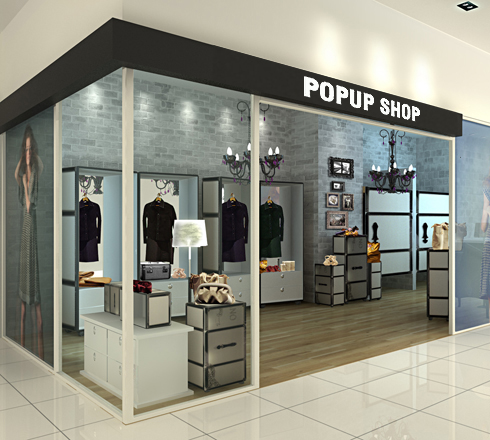One of the most underutilized reasons for brands to run pop-ups is to experiment with working with other companies. If brands have overlapping customer bases but don’t compete for wallet share, pop-up shops are a great way for them to inexpensively test those partnerships.
Of course, a brand should do their homework ahead of time to make sure that they’re aligning themselves with somebody who would appeal to the customer who they want to go after, and that the two brands are delivering similar value propositions, even though they make different products. Once that happens, it gives them a way to cross-market each other.
In addition to promoting each other’s products, the brand synergy can also amplify the message of the ultimate lifestyle that they’re delivering. J.Hilburn did this during their Fortnight in SoHo pop-up, and they had great success bringing in all sorts of strategic partners. For example, one partner was Daniel Wellington watches, which have a very engaged audience on Instagram and other social channels, which paired well with J.Hilburn’s extremely strong presence in more traditional media. When J.Hilburn was mentioned in the Wall Street Journal and the New York Times, or when Daniel Wellington watches were getting attention on their highly engaged social media channels, both parties benefitted. They weren’t competing: one sells watches, one sells clothing, but they’re appealing to the same type of man.
This situation was further enhanced at the J.Hilburn pop-up by bringing on more partners, all of whom targeted the same demographic, in order to round out that ideal lifestyle. This included the whiskey that they drank, the bourbon that was served, and the bottled water, which was Fred Water (a water bottle shaped like a flask that’s branded as very masculine). They had energy-infused turkey jerky. They covered all the bases. What does the brand think you’re going to eat, or drink, or do in your life? Having that water bottle, or a sip of that bourbon, or that snack just entrenches in the customer’s mind that this is the life I have if I shop this brand.
Nike and other athletic companies collaborate a lot as well: Nike x Riccardo Tisci, or Adidas x Stella McCartney, for example. Those collaborations make for great pop-ups because it’s introducing a new and unique capsule collection. You’re getting the story behind why the design happened or the aesthetic purposes of it or why they combined with that celebrity or designer. Maybe you’re getting to meet them as well.
This worked extremely well when Sarah Jessica Parker did her collaboration with Nordstrom. There’s a huge, active audience of women who have been watching her on Sex and the City for years and coveting her shoes. In my new book, I tell the story of the collaboration where women were able to go to a pop-up, meet Sarah Jessica Parker, and have her help them try on shoes! Even if they missed it, they were seeing the flurry online of women posting pictures on Instagram of themselves with her, and trying on the shoes. The customer can then check the full collection going forward at Nordstrom.
You often see similar kinds of collaborations happening in other stores as well, such as Target, where it’s not a new phenomenon. They’ve been collaborating with celebrities forever. Target has massive stores where there’s a lot going on, and most shoppers could easily miss a new collection. However, Target makes their partnership clear by hosting name-designer-for-Target pop-up stores, where shoppers are able to access a brand that they couldn’t normally afford. Target uses these pop-ups to promote their new collaborations, and to test which ones are working best.
When customers get to see a new collaboration firsthand, magic can happen. Brands that partnered with Target knew they would be popular, but when Target partnered with Missoni, they couldn’t even get through three days without selling out! That was one of many examples that has taught brands that collaborations with celebrities can happen successfully in an isolated pop-up environment before they actually hit the full stores.
As an added benefit, the brand can see immediately how popular the collaboration is. Depending on how nimble they are (it’s probably harder for sneaker brands than clothing brands, for example), they can potentially use this information to adjust how they’re going to approach merchandising when they actually hit the stores, or potentially do re-orders because they see, in a very isolated test market, how shoppers react.
However, even though pop-ups allow brands to test collaborations more inexpensively, not every celebrity works with every product or every audience. Don’t test everything! You still need to be thoughtful.
If you’re a brand that, price-point wise, aesthetic-wise, and style-wise, appeals to a woman whose average age is 40 to 50, and you have Selena Gomez or Miley Cyrus holding your bag, how does that help? You’re totally off brand. As a 40-year-old woman, I’m not going to be motivated to dive into that brand because Miley held it.
Now, if your core market was 15 to 20 years old girls, that would be appropriate. Despite being able to test collaborations inexpensively, your first line of defense against bad ideas is your own understanding of your brand. Ideally, your customers should look at all celebrity collaborations and think, “That’s somebody I see as cool. That’s somebody I aspire to be like. I value the way they carry themselves in life. If they do this, I’m going to at least try it or look into it, because I align myself with that person.”
So, give careful thought to your collaborations; make them appropriate for your target customer, not just hip with a generic “in crowd” (whatever that is!). Get it wrong, and you send a confusing message. Get it right, however, and the products walk out the door. Just ask Target!



